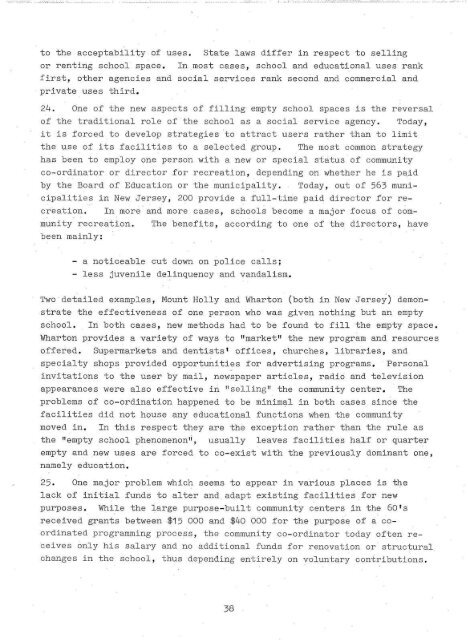BUILDING FOR SCHOOL AND COMMUNITY - Kennedy Bibliothek
BUILDING FOR SCHOOL AND COMMUNITY - Kennedy Bibliothek
BUILDING FOR SCHOOL AND COMMUNITY - Kennedy Bibliothek
Create successful ePaper yourself
Turn your PDF publications into a flip-book with our unique Google optimized e-Paper software.
to the acceptability of uses. State laws differ in respect to selling<br />
or renting school space. In most cases, school and educational uses rank<br />
first, other agencies and social services rank second and commercial and<br />
private uses third.<br />
24. One of the new aspects of filling empty school spaces is the reversal<br />
of the traditional role of the school as a social service agency. Today,<br />
it is forced to develop strategies to attract users rather than to limit<br />
the use of its facilities to a selected group. The most common strategy<br />
has been to employ one person with a new or special status of community<br />
co-ordinator or director for recreation, depending on whether he is paid<br />
by the Board of Education or the municipality. Today, out of 563 municipalities<br />
in New Jersey, 200 provide a full-time paid director for recreation.<br />
In more and more cases, schools become a major focus of community<br />
recreation. The benefits, according to one of the directors, have<br />
been mainly:<br />
- a noticeable cut down on police calls;<br />
- less juvenile delinquency and vandalism.<br />
Two detailed examples, Mount Holly and Wharton (both in New Jersey) demonstrate<br />
the effectiveness of one person who was given nothing but an empty<br />
school. In both cases, new methods had to be found to fill the empty space.<br />
Wharton provides a variety of ways to "market" the new program and resources<br />
offered. Supermarkets and dentists' offices, churches, libraries, and<br />
specialty shops provided opportunities for advertising programs. Personal<br />
invitations to the user by mail, newspaper articles, radio and television<br />
appearances were also effective in "selling" the community center. The<br />
problems of co-ordination happened to be minimal in both cases since the<br />
facilities did not house any educational functions when the community<br />
moved in. In this respect they are the exception rather than the rule as<br />
the "empty school phenomenon", usually leaves facilities half or quarter<br />
empty and new uses are forced to co-exist with the previously dominant one,<br />
namely education.<br />
25. One major problem which seems to appear in various places is the<br />
lack of initial funds to alter and adapt existing facilities for new<br />
purposes. While the large purpose-built community centers in the 60's<br />
received grants between $15 000 and $40 000 for the purpose of a coordinated<br />
programming process, the community co-ordinator today often receives<br />
only his salary and no additional funds for renovation or structural<br />
changes in the school, thus depending entirely on voluntary contributions.<br />
38
















